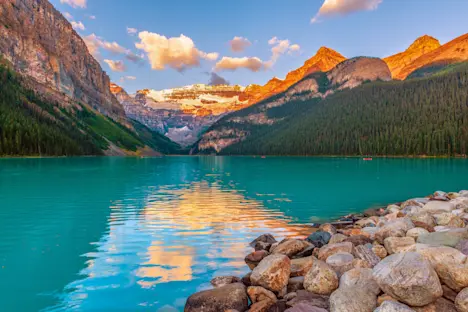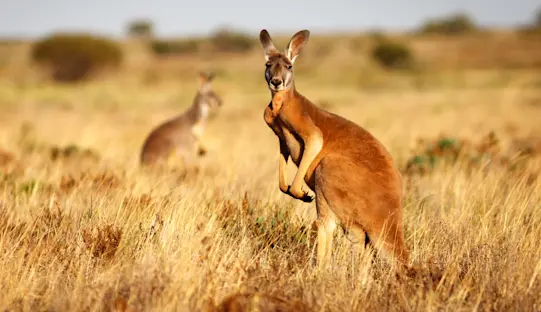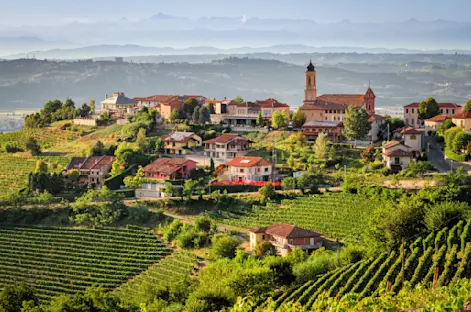
Wildebeest migrations have become a rarer sight in Africa as humans disrupt their historic migratory routes with cities, farmlands, fences, livestock and roads. This has led to genetic decay in those herds that are no longer able to roam freely.
Frogs, salamanders and other amphibians around the world are facing mounting threats from climate change, a devastating fungus and habitat loss. And there’s another danger that’s uniquely immediate: road mortality. Roads often cut through critical migration corridors, allowing vehicles to crush millions of amphibians each year.
Roads are present perils for another, larger group of animals: wildebeests. Their migrations in Africa have become a rarer sight as humans continue to interrupt their historic migratory routes with cities, farmlands, fences, livestock and the roads that inevitably come with them. This has led to genetic decay in those wildebeest herds that are no longer able to roam freely.
It’s now clear that no one type of corridor for avoiding highways and roads benefits all animals. Our wildlife overpasses, tunnels and underpasses need to be built smarter, to benefit some of the smallest animals to some of the largest.

Amphibians are crucial for healthy ecosystems. They control insect populations, serve as both predators and prey, and act as bioindicators of environmental health. Their diverse habitats and unique physiologies contribute to the balancing of ecosystems, food webs and nutrient cycling.
Underpasses for amphibians
Amphibians play vital roles in ecosystems and are highly sensitive to environmental disruption. In Vermont and much of the northeastern United States, many amphibians spend the majority of their lives hidden in upland forest soils or streams, fattening up and surviving long winters underground. But in early spring, they emerge en masse (in the hundreds or even thousands) on warm, rainy nights to migrate from upland woods to flooded meadows, ponds and wetlands to breed.
Unfortunately, roads are often built right between the steeper, forested uplands and the flatter, aquatic habitats, exactly where amphibians must cross. And because amphibians are small and slow-moving, they are especially vulnerable to collisions with automobiles. Unlike large mammals that might dart across a road in seconds, frogs and salamanders can take several minutes to cross. And with hundreds migrating at once, mortality rates can be staggering.
Now, a new, first-of-its-kind study offers powerful evidence that a simple intervention—wildlife underpass tunnels—can dramatically reduce these amphibian deaths and help preserve ecosystems.
In research that spanned more than a decade, scientists from the University of Vermont (UVM), the Vermont Agency of Natural Resources and people from the local community assessed the effectiveness of two wildlife underpasses installed under a road in Monkton, Vermont.

Small and slow-moving, amphibians are especially vulnerable to vehicle collisions. Unlike larger animals that might dart across a road in seconds, frogs and salamanders can take several minutes to cross.
Back in 2006, residents gathered to observe a known migration corridor. What they saw shocked them. In just two nights, they counted more than a thousand dead animals on the road. That community concern helped launch a collaboration between conservation groups, residents, state agencies and UVM scientists. Together, they constructed two amphibian underpasses beneath a 0.8-mile stretch of road in Monkton.
These structures—four-foot-wide, concrete tunnels with wing walls to guide amphibians into them and safely under the road—were installed in 2015 with the support of the Vermont Fish and Wildlife Department and the Town of Monkton. The project cost $342,397, which is far lower than large mammal overpasses and underpasses, which can range from $500,000 to nearly $100 million per crossing.
Using wildlife cameras in the spring of 2016, researchers counted 2,208 amphibians using the underpasses. Other animals were happy to use the tunnels, too. The cameras captured bears, birds, bobcats, porcupines, raccoons and snakes also taking advantage of the structures, suggesting that they broadly benefit ecosystem connectivity.
For the recent UVM study, the researchers used a rigorous “before-after-control-impact” (BACI) design. The citizen scientists and researchers monitored amphibian road mortality over five years before the construction of the underpasses (2011–2015) and seven years after (2016–2022). They compared three zones: one with underpasses and wing walls (treatment), one covering the area at and beyond the end of wing walls away from the tunnels (buffer) and a control area far from the infrastructure changes.

Wildlife underpass tunnels—such as this one in the Netherlands—can dramatically reduce amphibian deaths and help preserve ecosystems.
The study team conducted standardized surveys during the amphibians’ brief spring migration windows, walking the road each rainy evening and recording every amphibian—alive or dead—across 12 species of frogs, salamanders and toads. They found 5,273 amphibians, including 1,702 spotted salamanders, nearly half of which were dead, and 2,545 spring peeper frogs, nearly 70% of which were dead. The death rates were much lower in the treatment areas, and the buffer areas, too, showed that the animals were using the tunnels and not just being displaced to the ends of the walls.
After analysis, the scientists found the results striking: an 80.2% reduction in amphibian deaths. And when they took climbing amphibians out of the picture, primarily spring peeper frogs, there was a 94% decrease in mortality. The study was published online in the Journal for Nature Conservation and will be printed in the August 2025 edition of the journal.
This research provides the first long-term, peer-reviewed evidence that amphibian-specific wildlife underpasses in the northeastern U.S. are highly effective. It also highlights that design details—like angles, wall height, tunnel layout and materials—matter. It’s hoped these findings will serve as a model for planners and policymakers as roads are built and repaired across the country.

The annual migration of 1.3 million wildebeests through Tanzania’s Serengeti and Kenya’s Maasai Mara attracts hundreds of thousands of tourists. The phenomenon has put the Serengeti on UNESCO’s list of World Heritage sites. About 200,000 zebras and 400,000 gazelles accompany the wildebeests.
Roadless corridors for wildebeests
Whether by way of naturalist David Attenborough, Disney or National Geographic, the iconic scene is familiar to many. The ground trembles and clouds of dust swirl as enormous hordes of wildebeests thunder across the African savanna, cross rivers and are picked off by crocodiles, hyenas and lions.
The annual migration of 1.3 million wildebeests through Tanzania’s Serengeti and Kenya’s Maasai Mara attracts hundreds of thousands of tourists, and the phenomenon has put the Serengeti on UNESCO’s list of World Heritage sites. Besides the majestic sight, the migration of this emblematic species is important for the ecological functioning of many ecosystems.
Unfortunately, epic annual migrations of this scale are only found in a few places on the African continent now. In some areas, farms, fences, urban sprawl and roads have fractured the historic migratory routes of wildebeest herds and prevented them from roaming far and wide in search of fresh grass and water. A new study led by researchers from the University of Copenhagen shows that as a consequence, the genetic health of wildebeests has suffered.
Until recently, no one knew that this affected the genetics of wildebeests. But by analyzing the genomes of more than a hundred animals from throughout their entire range, the researchers were able to make a general genetic comparison of migratory versus nonmigratory populations. And because they witnessed a consistent difference across multiple locations, the conclusion is clear. Wildebeest populations that no longer migrate but have historically done so are less genetically healthy than those that continue to migrate. They have less genetic diversity and are more inbred, and this weakens their chances of long-term survival.

Researchers recently analyzed the whole genomes of 121 wildebeests to study the genetic effect of migration. While the animals are not currently threatened, herds that can no longer migrate will likely be worse off in the face of climate change due to low genetic diversity.
Overall, this iconic savanna grazer is not currently threatened. But many local populations have experienced steep declines, and several have even collapsed in recent decades. In the long run, wildebeest herds that can no longer migrate will likely be worse off in the face of climate change. Evolutionary potential is reduced in populations with low genetic diversity. So, if climatic changes continue to occur, there isn’t as much genetic variation for the wildebeests to work with to adapt, which could ultimately threaten their survival. The Serengeti-Mara migration is also threatened by plans for roads and rail corridors through the area, which worries many.
As a species, wildebeests are dependent on migrations to support their large numbers. They can survive in resident, nonmigratory populations, but their numbers shrink when they cannot migrate. For example, in the populations in the other parts of Kenya and Tanzania that have been prevented from migrating, numbers have decreased.
The researchers hope that these new results will inspire investigations into the genetic effects of reduced migrations among other species, as well. They add that wild animals struggle to survive in an increasingly human-dominated world, and special attention needs to be paid to preserving their natural, old migratory routes. This concern is not just in regard to wildebeests, but also for other migratory species in Africa and elsewhere.
Smarter designs for wildlife corridors
As human populations and developments continue to expand, it’s more important than ever to set aside corridors of undeveloped land where wildlife can travel safely, helping to ensure their persistence.

The Florida black bear is the only bear species in Florida. Once abundant, Florida black bear numbers declined significantly in the late 1960s. Today, the animals are found in many habitats, including flatwoods and swamps, but they are increasingly encountering humans due to urban developments.
In Florida, black bear populations were once threatened but have been rebounding and continue to spread. However, better methods for constructing wildlife corridors are needed; if we don’t get them right, our efforts at conservation will fail, and we could see more human-wildlife conflicts.
So recently, University of Maryland researchers tested different wildlife corridor designs against black-bear movement data in Florida. They used three different mathematical models to create theoretical wildlife corridors for black bears in Florida and compared them to tracking data to determine how the animals actually move through the environment. They also compared their model corridors to the existing Florida Wildlife Corridor, a network of public and private conservation lands across the state designated as a multispecies corridor.
To develop potential corridors, the team combined information on bear habitats and where the animals are likely to live with landscape features and information on how easy or difficult it is for them to move through the environment. The study revealed how tricky it can be to define “easy movement” and then use it to develop corridor parameters. For example, traveling across open farm fields and roadways may be physically easier for a bear than traveling through dense woods, but that’s not where you want bears to go. While an urban area could be considered more difficult for a bear to traverse, some bears will waltz right through town to find the local trash dump that offers lots of food.

The Florida Wildlife Corridor, designated in 2021, comprises nearly 18 million acres of contiguous wilderness and working lands crucial to the survival of many of Florida’s 131 imperiled animals. The corridor also protects water quality and strengthens resilience against intensifying storms.
So, the team developed three different approaches for defining “difficult movement” and created three gridded maps of Florida, each with varying levels of “resistance” built into the landscape. They then used a program called Circuitscape to combine their resistance grids with bear habitat information and developed maps showing the most likely flow of bear movements in the state. They can be thought of as road maps that show multiple bear “highways” with more or less likely bear traffic. They then used those maps to create three potential corridors and overlaid them with GPS tracking data on the real movements of 30 bears, each of which had been intensively tracked for an extended period.
The results, published in the journal Landscape Ecology in September 2024, were mixed, and how well any corridor did changed depending on bear behaviors. None captured all black-bear movements.
For example, the corridor that had the least overlap with bear movements and scored the lowest in most evaluations was the only corridor that included the wanderings of a single, unique bear that had a mind of his own. That’s what’s called a “dispersal movement,” when an individual moves to a completely new location looking for a new home. If one bear does it, others may, too; and that’s how animals establish themselves in new territories. While that’s what the scientists wanted to document, the best overall models completely failed to capture that unique bear movement.
Additionally, their testing results varied widely depending on the evaluation method used. This work highlights the complexity of the issues involved and shows that there is no one best method for building a wildlife corridor. Their purposes vary widely and will directly impact what approach should be considered to achieve certain conservation goals.

Not all wildlife corridors have the same goal. One may need to provide access to new habitats for an expanding population, and another may aim to improve genetic diversity by connecting populations that are separated by developments.
Creating corridors often means government agencies, municipalities or nonprofits purchase and protect expensive tracts of land or work with builders to conserve areas that might otherwise be developed. The lands chosen for conservation are often determined by scientific modeling based on animal movements and landscape features.
But the needs of different species in different locations are complex, and not all corridors have the same goal. One may need to provide access to new habitats for an expanding population, and another may aim to improve genetic diversity by connecting populations that are separated by developments. In addition to these intricacies, conserving wildlife corridors is expensive, and yet it remains unknown how different design methods influence their effectiveness or how to evaluate whether they are working for the intended purpose.
Furthermore, what works for some animals may not work for all. The Florida Wildlife Corridor is considered a multispecies corridor that covers a large area, but it includes fewer bears per square mile than the bear-specific model corridors the team designed.
The study challenges the often-raised idea that any wildlife corridor is always better than no corridor. It may be true that any conservation effort is better than none, but this work demonstrates that more research and resources are needed to ensure that the efforts and expenses of building wildlife corridors do not go to waste, especially as we continue to experience shrinking wildlife habitats and a changing climate.

Our roads can take us on incredible journeys and change the courses of our lives. However, we must make sure that our roads don’t trample the routes of the more-than-humans among us.
Directions and roads for all who travel
The migrations of wildebeests make them a keystone species in ecosystems, as their grazing keeps vegetation healthy, transporting and distributing nutrients, while they themselves serve as prey for predators and carrion for scavengers. Therefore, it isn’t just the one, iconic animal that we threaten when we prevent them from migrating with our developments and roads—but many other species, as well. And to the benefits they provide, we might add the enormous amount of tourism revenue that aids governments and local communities.
Likewise, the amphibian study shows us that corridors and structures are not just helpful for wild animals; they are a signal that human communities can come together to protect their local ecosystems. This story began with people who were concerned and engaged, and it provides a template for how other communities can protect their wildlife, too.
The roads we create can take us on incredible journeys and change the courses of our lives. We just have to make sure that in the process they don’t destroy and pave over the paths of the more-than-humans among us.
Here’s to finding your true places and natural habitats,
Candy






























